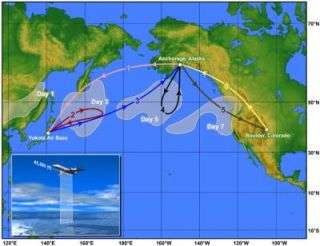Scientists to track impact of Asian dust and pollution on clouds, weather, climate change

Scientists using the nation's newest and most capable aircraft for environmental research are launching a far-reaching field project this month to study plumes of airborne dust and pollutants that originate in Asia and journey to North America. The plumes are among the largest such events on Earth, so great in scope that scientists believe they might affect clouds and weather across thousands of miles while playing a role in global climate.
The PACDEX (Pacific Dust Experiment) project will be led by scientists at the National Center for Atmospheric Research and Scripps Institution of Oceanography. NCAR's main sponsor, the National Science Foundation (NSF), will provide most of the funding. The first mission will be launched in late April, with the exact start date dependent on weather patterns in Asia. The project will continue for almost two months.
"PACDEX will open a window into what happens to the atmosphere as these massive plumes cross the Pacific Ocean. The plumes affect clouds, precipitation, and the amount of sunlight that reaches Earth," explains NCAR scientist Jeff Stith, a principal investigator on the project. "We want to determine how the various particles of dust and pollutants in the plumes influence clouds and climate, and how far downwind those effects occur."
Impacts on climate change and weather
While many particles in the plumes, such as sulfates, cool the planet by blocking solar radiation from reaching Earth, other particles, such as black carbon, can have a warming effect. Black carbon produces warming by absorbing sunlight both at ground level, where the particles are deposited on snow cover, and in the air, where sunlight otherwise would have been reflected back into space.
Particles may mask up to half of the global warming impact of greenhouse gases. Warming in the coming decades will be strongly influenced by how particle emissions change, particularly in Asia.
The plumes can also alter global temperatures by interacting with large-scale, midlatitude cloud systems over the Pacific that reflect enormous amounts of sunlight and help regulate global climate. The plumes may affect regional precipitation patterns because water vapor molecules adhere to microscopic dust and pollution particles to form water droplets or ice particles that eventually grow and fall out of the clouds as rain or snow. In addition, the dust and pollutants reduce the amount of light reaching Earth, contributing to a phenomenon known as global dimming that can affect both temperatures and precipitation.
"PACDEX comes at a crucial time in our efforts to understand the regional impacts of global warming," says V. Ramanathan, a PACDEX principal investigator based at Scripps Institution of Oceanography. "It will also help us examine how the dust and soot modify storm tracks and cloud systems across the Pacific, which influence North American weather patterns in major ways. By focusing on these plumes, PACDEX will shed light on one of the major environmental issues of this decade."
Japan to North America
As Asia's economies boom, scientists are increasingly turning their attention to the plumes, which pack a combination of industrial emissions (including soot, smog, and trace metals) and dust. The plumes are lofted by storms that originate in regions such as Central Asia's Gobi Desert.
To study changes in the plumes as they move through the atmosphere from Japan to the western United States, the PACDEX team will deploy the NSF/NCAR Gulfstream-V aircraft. This newly configured jet has a range of about 6,000 miles and can cruise at altitudes from just a few hundred feet above Earth's surface to over 50,000 feet, enabling scientists to study the plumes across thousands of miles and at different levels of the atmosphere. The Gulfstream-V will carry an array of instruments that will enable scientists to both collect data on clouds and to bring dust, pollutants, and cloud particles into the aircraft for study.
Source: National Center for Atmospheric Research




















